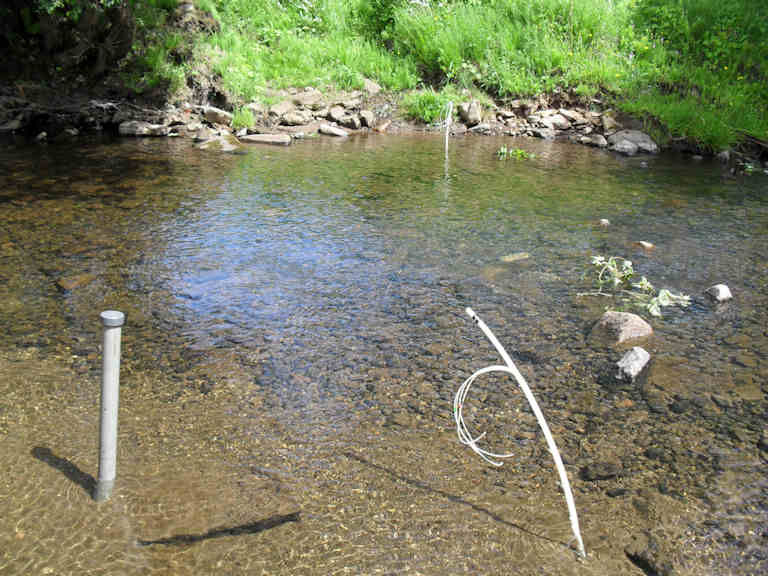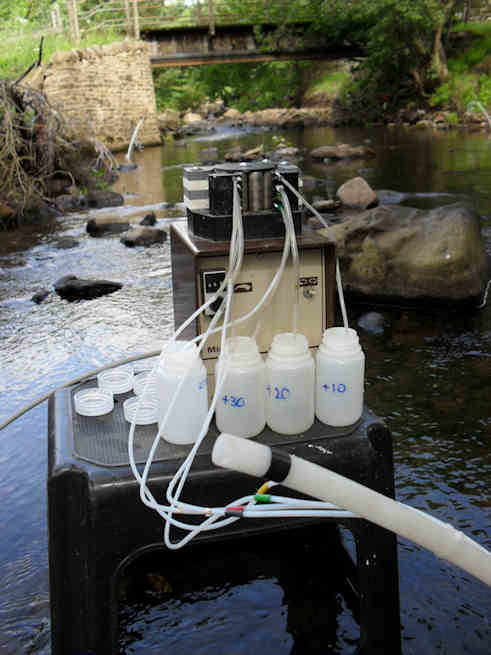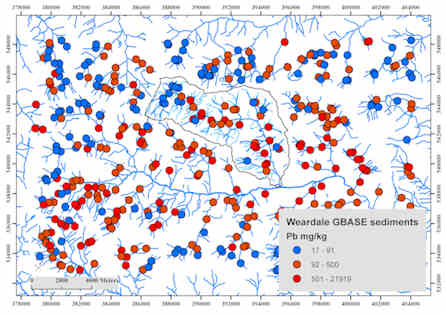Hyporheic zone in mine impacted catchments
Contaminated sediments in the hyporheic zone may represent a significant source of diffuse pollution in catchments impacted by metal mining.
Resultant damage to aquatic ecosystems could contribute to failure of Water Framework Directive (WFD) good ecological status.
Contaminant inputs from the hyporheic zone could diminish the benefits delivered by remediation of point source contamination (e.g. mine water discharges).
The BGS Geochemical Baseline Survey of the Environment (G-BASE) national dataset of the chemical composition of sediments highlights the scale of the problem in mineralised areas of England and Wales.
Case study: Rookhope Burn, Weardale, UK

The catchment of the Rookhope Burn in County Durham (northern England) has been affected by historical mining and processing of lead (Pb) and zinc (Zn) ore.
We chose this stream for detailed study as it is one of the most severely mine impacted (in terms of water quality) in England and Wales.
It is also representative of catchments affected by the mining legacy in the Northern Pennine Orefield.
The Rookhope Burn is a tributary of the River Wear, with a catchment about 37 km2. Superficial deposits and mine-reworked sediments are distributed widely throughout the channel.
Previous studies have identified zinc in surface water as the contaminant of concern within this catchment, which the Environment Agency considers to be at risk of failing to achieve good water quality status in the context of the WFD.
Main research findings and WFD implications
Our main findings and their implications for the Water Framework Directive are (for further information please refer to our publications):
- Circumneutral pH and oxidising conditions characterise the hyporheic zone of the study reach, composed of coarse-textured bed sediments. Large vertical concentration gradients were observed for manganese (Mn), iron (Fe), Pb and Zn.
- Significant interaction between solutes and the hyporheic sediments influenced by solute residence time controlled the hyporheic pore water Zn composition and its temporal changes. These temporal variations warrant consideration when accounting for the natural attenuation capacity of a stream as remediation strategy.
- We have showed that Pb concentrations are consistently higher in the hyporheic pore water than in surface water and that the hyporheic zone represents an important diffuse source of Pb contamination to the stream, due to the widespread contamination of Pb-rich sediments in the study catchment, from centuries of lead ore mining.
- Despite the fact that the surface water has relatively low concentrations of dissolved Pb, the enhanced Pb concentration in the hyporheic zone can have an adverse impact on the riparian biota and may impede the good ecological status of the stream.
- The significance of the sediment-scale hyporheic processes at the reach-scale was estimated by comparing our results to mass balance calculations of contaminant load gains and losses for the reach. These results closely agreed with our observations at the stream bed sediment scale, supporting the importance of hyporheic solute exchanges in affecting the surface water quality for the study stream.
Field sampling and lab experiments

We employed a range of methods to study the Rookhope Burn:
- Measurements in the field such as flow monitoring and chemical analysis of inflows and instream waters throughout the catchment, to enable mass balance calculations and estimate losses and gains of contaminants in the stream.
- Installation of multilevel samplers to a depth of 0.4 m in the stream bed to monitor the variability of the hyporheic zone pore water at the sediment scale. Deployment of in-situ diffuse gradients in thin films (DGT) in the stream bed: these accumulate bioavailable metals which can be quantified in the laboratory after recovery of the sampler.
- Samples of sediments and sediment interstitial water for chemical analysis.
- Monitoring how the chemistry of stream water mixed with stream bank sediments in the lab changed over an 88 day period in inundation tests.
Publications
Palumbo-Roe, B, Wragg, J, and Banks, V. 2012. Lead mobilisation in the hyporheic zone and river bank sediments of a contaminated stream: contribution to diffuse pollution. Journal of Soils and Sediments, 12(10): 1633–1640.
Palumbo-Roe B, and Dearden R. The hyporheic zone composition of a mining-impacted stream: evidence by multilevel sampling and DGT measurements. Submitted to Applied Geochemistry.
Wragg, J, and Palumbo-Roe, B. 2011. Contaminant mobility as a result of sediment inundation: literature review and laboratory scale pilot study on mining contaminated sediments. British Geological Survey, 90pp. (OR/11/051)
Banks, V J, and Palumbo-Roe, B. 2010. Synoptic monitoring as an approach to discriminating between point and diffuse source contributions to zinc loads in mining impacted catchments. Journal of Environmental Monitoring, 12(9): 1684–1698.
Dearden, R A, and Palumbo-Roe, B. 2010. Technical notes: hyporheic zone sampling procedures. British Geological Survey, Open Report OR/10/048.
Contact
Contact Dr Barbara Palumbo-Roe for further information.
- Lead mobilisation in the hyporheic zone and river bank sediments of a contaminated stream: contribution to diffuse pollution
- Synoptic monitoring as an approach to discriminating between point and diffuse source contributions to zinc loads in mining impacted catchments
- Technical notes: hyporheic zone sampling procedures
- The Hyporheic Handbook, the product of a NERC-funded Knowledge Transfer Network







